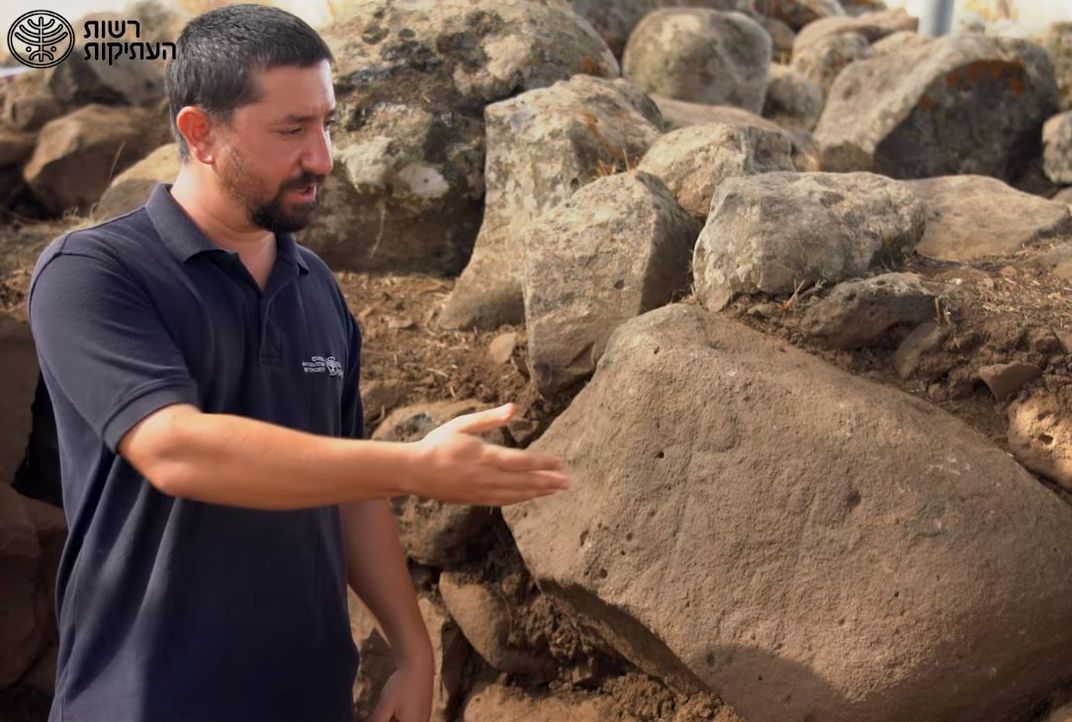Archaeologists in Golan Heights Unearth Fort Dated to Time of Biblical King David
Researchers say the newly discovered site was probably part of the enigmatic Kingdom of Geshur
/https://tf-cmsv2-smithsonianmag-media.s3.amazonaws.com/filer/d6/36/d6369872-5cb2-4654-ba4c-e737d7d3e9d1/dig_screenshot2.jpg)
Archaeologists in the Golan Heights, a 500-square-mile plateau claimed by both Israel and Syria, have found the ruins of the area’s oldest known fortified settlement. As Amanda Borschel-Dan reports for the Times of Israel, the structure appears to date to the time of the biblical King David and may have been part of the Kingdom of Geshur.
The Israel Antiquities Authority (IAA) excavated the site in advance of planned construction of a new neighborhood near the Israeli settlement of Hispin. During the dig, researchers unearthed rock etchings inside the fort that showed two figures with raised arms, possibly praying toward the moon. They also discovered a statuette of a woman holding a musical instrument that looks like a drum.
“We understood that we had something very, very important,” says dig co-director Barak Tzin, an archaeologist at the University of Haifa, in a Hebrew video translated by the Times. “We were astonished to discover a rare and exciting find: a large basalt stone with a schematic engraving of two horned figures with outspread arms.”
The fort—which covered more than a quarter of an acre, as Tzin tells Agence France-Presse—is built of basalt boulders and has walls measuring almost five feet thick. Based on pottery shards and other physical evidence, the researchers date the fort to between the 11th and 9th centuries B.C.
Tzin says the artifacts are similar to some found in the ruins of Bethsaida, a city west of the new excavation site that archaeologists say was once the Kingdom of Geshur’s capital. Last year, archaeologists working at Bethsaida found a stone carving depicting a horned figure believed to represent worshippers of a moon god. In a statement, Tzin and his team say that it’s possible someone copied the image to create a local version at the newly discovered fort.
The Bible describes the Geshurite people as allies of the House of David who lived north of the Sea of Galilee. According to biblical accounts, one of David’s wives, Maacah, was the daughter of Geshur king Talmi.
Ron Be’eri, scientific advisor to the IAA, tells the Times that little little historical documentation of the era, which follows the fall of the northern Hittite empire around 1180 B.C., survives.
“There is a big vacuum,” he says. “There is no historian that writes the history of the era and we return to a sort-of ‘pre-history’ in which we only have physical artifacts to base our assumptions upon.”

Be’eri adds that since biblical texts were written under the authority of kings with their own agendas, it’s difficult to correlate the possible historical content in these stories with real-world artifacts.
Speaking with Haaretz’s Ariel David, Israel Finkelstein, an archaeologist at Tel Aviv University who wasn’t involved in the new research, argues that biblical mentions of Geshur’s links to the Israelites actually reference a later period than previously suggested.
“As far as I can judge, the biblical references to the connection with this kingdom portray memories of realities of the ninth century (and specifically of the Northern Kingdom), retrojected by the later biblical author to the time of King David,” Finkelstein explains.
Archaeologists have previously found cities believed to be part of Geshur—including Tel En Gev, Tel Hadar and Tel Sorag—along the shore of the Sea of Galilee, but Tzin tells AFP that less archaeological work has been conducted in the Golan.
“We’re only beginning to rediscover the Golan now,” he says.
Tzin adds that the find near Hispin “fills out [the] middle” of the ancient kingdom, which researchers believe extended to modern-day Syria.
Be’eri tells the Times that the fort’s very existence speaks to the conflict in the area that occurred after the demise of the northern Hittite empire.
“The complex we exposed was built at a strategic location on the small hilltop, above the El-Al Canyon, overlooking the region, at a spot where it was possible to cross the river,” say Tzin and dig co-director Ennon Bron in the statement.
/https://tf-cmsv2-smithsonianmag-media.s3.amazonaws.com/accounts/headshot/Livia_lg_thumbnail.png)
/https://tf-cmsv2-smithsonianmag-media.s3.amazonaws.com/accounts/headshot/Livia_lg_thumbnail.png)